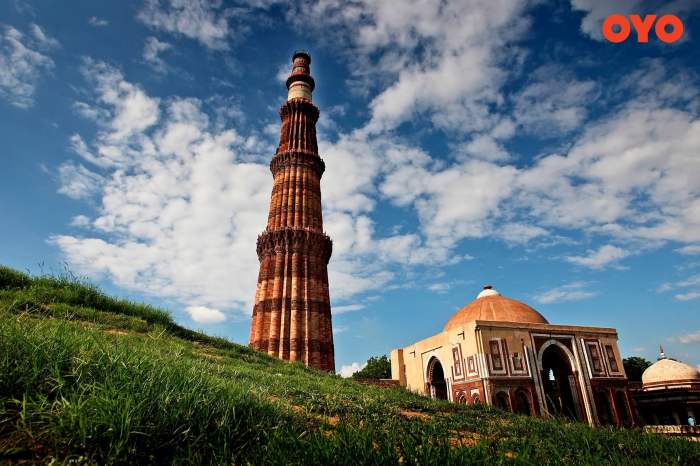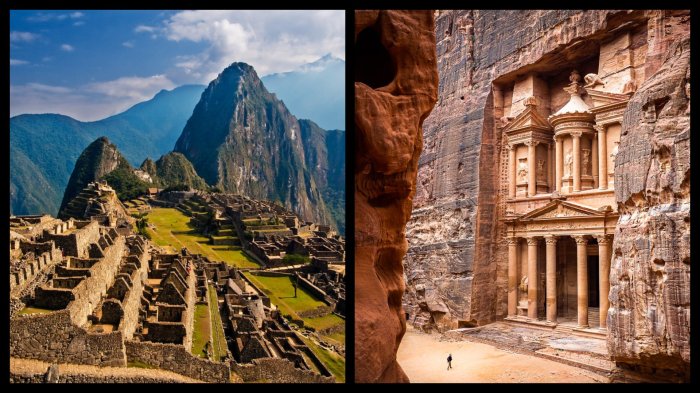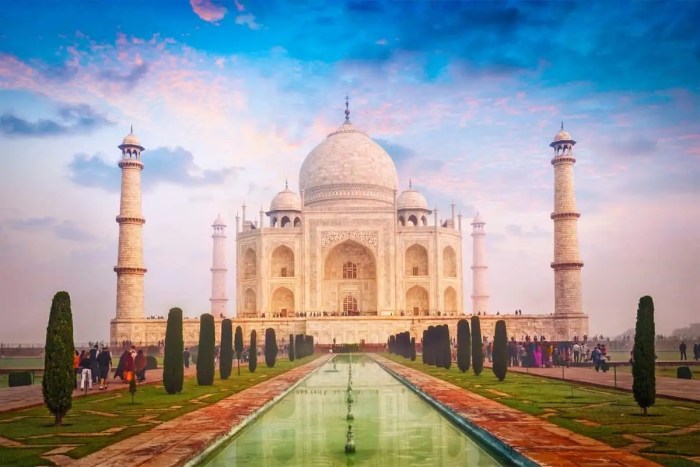UNESCO World Heritage Sites are landmarks of global significance, showcasing the rich tapestry of human history and cultural heritage. Designated by the United Nations Educational, Scientific and Cultural Organization (UNESCO), these sites represent the finest examples of our collective past and present.
From ancient ruins to modern architectural marvels, natural wonders to cultural landscapes, UNESCO World Heritage Sites encompass the diversity of human creativity and ingenuity. They serve as a testament to our shared heritage and inspire awe and wonder in all who visit them.
Historical Significance and Cultural Value
UNESCO World Heritage Sites are of paramount importance in preserving and celebrating global history and culture. They represent tangible and intangible heritage of outstanding universal value that bear witness to the diversity of human civilization and the natural world.
Discover the wonders of UNESCO World Heritage Sites in style with luxury travel deals. Immerse yourself in the cultural and historical significance of these remarkable destinations, from ancient ruins to awe-inspiring natural landscapes. Embark on exclusive guided tours, indulge in fine dining experiences, and stay in opulent accommodations, ensuring a truly unforgettable exploration of UNESCO World Heritage Sites.
The criteria used to designate a site as a World Heritage Site are rigorous and comprehensive. Sites must meet at least one of ten selection criteria, which assess their cultural, historical, architectural, scientific, or natural significance.
Examples of Iconic World Heritage Sites
- The Great Wall of China (China): A symbol of Chinese civilization and engineering prowess, it is one of the largest and most iconic structures ever built.
- The Taj Mahal (India): A masterpiece of Mughal architecture, it was built as a mausoleum for Emperor Shah Jahan’s wife, Mumtaz Mahal.
- The Pyramids of Giza (Egypt): Ancient tombs built for the pharaohs Khufu, Khafre, and Menkaure, they are among the most recognizable structures in the world.
- The Colosseum (Italy): An iconic amphitheater in Rome, it was used for gladiatorial contests and public spectacles.
- The Great Barrier Reef (Australia): The world’s largest coral reef system, it is home to a diverse array of marine life and is a popular tourist destination.
Geographical Distribution and Diversity: UNESCO World Heritage Sites
UNESCO World Heritage Sites are spread across the globe, showcasing the remarkable diversity of our planet’s cultural and natural heritage. The geographical distribution of these sites reflects the rich tapestry of human history and the interconnectedness of our natural world.
Europe and Asia are the regions with the highest concentration of World Heritage Sites, boasting over 500 sites each. This is a testament to the long and rich cultural history of these regions, with many iconic landmarks and historical monuments. The Americas and Africa also have a significant number of World Heritage Sites, highlighting the diverse cultural traditions and natural wonders found on these continents.
From the depths of the Great Barrier Reef to the heights of the Great Wall of China, UNESCO World Heritage Sites offer a glimpse into the world’s most awe-inspiring wonders. For thrill-seekers looking to combine exploration with adventure, extreme sports vacations offer the perfect blend of adrenaline and cultural immersion.
Whether it’s paragliding over the Swiss Alps or rock climbing in Thailand, these experiences provide a unique way to connect with the world’s most iconic destinations.
Diversity of Natural and Cultural Sites
The World Heritage List includes a wide range of natural and cultural sites, each with its own unique significance. Natural sites encompass a variety of geological formations, ecosystems, and habitats, including rainforests, mountains, deserts, and marine environments. Cultural sites include historical monuments, archaeological sites, and cultural landscapes that showcase the achievements and creativity of human civilizations.
This diversity ensures that the World Heritage List represents the full spectrum of our planet’s heritage. It allows us to appreciate the beauty and fragility of our natural world, while also celebrating the ingenuity and cultural achievements of humanity.
Natural Heritage Sites

Natural heritage sites encompass areas of outstanding universal value for their geological and biological significance. These sites protect ecosystems and biodiversity, providing a sanctuary for rare and endangered species and preserving unique habitats.
Exploring UNESCO World Heritage Sites can be an enriching experience for families. These sites offer a glimpse into history, culture, and nature. While some may assume these destinations are expensive, it’s possible to incorporate them into budget family vacations.
By planning ahead and taking advantage of free or low-cost activities, families can create memorable experiences while preserving these remarkable landmarks.
Examples of natural heritage sites include:
- The Grand Canyon, renowned for its intricate geological formations and diverse ecosystem.
- The Great Barrier Reef, home to an unparalleled array of marine life and coral species.
- The Amazon rainforest, the largest rainforest in the world and a vital reservoir of biodiversity.
Challenges and Opportunities in Management and Conservation
Managing and conserving natural heritage sites presents both challenges and opportunities. One challenge lies in balancing the preservation of these sites with the needs of local communities and economic development.
Another challenge is the impact of climate change on these ecosystems. Rising sea levels, changing weather patterns, and increased frequency of extreme events can threaten the integrity of natural heritage sites.
Despite these challenges, there are also opportunities to enhance the conservation of these sites. Ecotourism can provide economic incentives for local communities to protect and sustainably manage natural heritage sites.
Collaboration between governments, conservation organizations, and local communities is essential to ensure the long-term protection of these valuable ecosystems.
Cultural Heritage Sites

Cultural heritage sites are physical or tangible expressions of human culture that are considered to have outstanding universal value. They include a wide range of sites, such as monuments, archaeological sites, and cultural landscapes.
Categories of Cultural Heritage Sites
- Monuments: Isolated structures or groups of structures that are significant for their architectural, historical, or artistic value, such as castles, cathedrals, and palaces.
- Archaeological Sites: Areas that contain evidence of human activity from past periods, such as ancient cities, burial grounds, and battlefields.
- Cultural Landscapes: Areas that have been shaped by human interaction with the natural environment, such as agricultural landscapes, urban areas, and industrial sites.
Examples of Iconic Cultural Heritage Sites
Some iconic cultural heritage sites include:
- The Great Wall of China (China) – A massive fortification built over centuries to protect against nomadic tribes.
- The Taj Mahal (India) – A white marble mausoleum built by Mughal emperor Shah Jahan in memory of his wife.
- The Colosseum (Italy) – An ancient amphitheater that was used for gladiatorial contests and public spectacles.
- The Pyramids of Giza (Egypt) – A complex of ancient tombs built as burial chambers for pharaohs.
- The Great Barrier Reef (Australia) – The world’s largest coral reef system, home to a diverse range of marine life.
Importance of Safeguarding Cultural Heritage Sites
Cultural heritage sites are important because they provide a tangible connection to the past and help us to understand our shared human history. They also contribute to our sense of place and identity, and can be a source of economic and social benefits through tourism and cultural activities. However, cultural heritage sites are often threatened by urbanization, tourism, and natural disasters. It is important to safeguard these sites through conservation and management efforts to ensure that they are preserved for future generations.
Tourism and Sustainable Development

UNESCO World Heritage Sites attract millions of tourists annually, contributing significantly to local economies. However, tourism can also pose challenges, including environmental degradation and cultural appropriation. Sustainable tourism practices aim to balance economic benefits with conservation goals.
Tourism’s Role in Promoting and Generating Revenue
- Creates employment opportunities in hospitality, transportation, and retail sectors.
- Supports local businesses, including artisans and cultural performers.
- Provides revenue for conservation and preservation efforts.
Potential Impacts of Tourism
Environmental Degradation
- Increased pollution from transportation and waste.
- Habitat disturbance and wildlife displacement.
- Water scarcity and resource depletion.
Cultural Appropriation
- Misrepresentation or commercialization of cultural traditions.
- Erosion of local customs and values.
- Disrespectful behavior towards indigenous communities.
Strategies for Sustainable Tourism, UNESCO World Heritage Sites
Balancing economic benefits with conservation goals requires sustainable tourism strategies:
- Responsible planning and management: Limit visitor numbers, establish designated trails, and minimize infrastructure development.
- Education and interpretation: Educate tourists about the site’s cultural and natural significance to foster respect and understanding.
- Community involvement: Engage local communities in tourism planning and management to ensure their voices are heard.
- Eco-friendly practices: Promote the use of renewable energy, waste reduction, and sustainable transportation.
- Tourism certification: Encourage businesses to adopt sustainable practices through certification programs.
Education and Outreach

UNESCO World Heritage Sites serve as invaluable platforms for fostering cultural awareness and global citizenship. They offer a tangible connection to the past, present, and future, inspiring a deeper understanding of different cultures and their contributions to human civilization.
Various initiatives and programs harness the educational potential of these sites. Guided tours, educational materials, and interactive exhibits provide visitors with immersive experiences that bring history to life. Additionally, outreach programs extend the reach of these sites to schools, communities, and online platforms, making their lessons accessible to a wider audience.
Successful Educational Campaigns
Successful educational campaigns have played a pivotal role in raising awareness about World Heritage Sites and their importance. These campaigns have employed creative and engaging approaches to capture the attention of diverse audiences.
- World Heritage Youth Forum: This initiative engages young people in the preservation and promotion of World Heritage Sites through workshops, field trips, and youth-led projects.
- “Seven Wonders of the World” Campaign: This global campaign highlighted the importance of cultural heritage by showcasing iconic World Heritage Sites and their cultural significance.
- UNESCO Memory of the World Programme: This program recognizes and preserves documentary heritage that is of global significance, providing valuable educational resources for scholars and the public alike.
Summary

UNESCO World Heritage Sites are not only symbols of the past but also vital resources for the future. They provide insights into our history, foster cultural understanding, and promote sustainable development. By preserving and protecting these sites, we safeguard our collective heritage for generations to come.
FAQ Section
What are the criteria for designating a site as a UNESCO World Heritage Site?
UNESCO uses ten selection criteria to evaluate sites for World Heritage status. These criteria assess the site’s cultural, historical, architectural, natural, and scientific significance.
How many UNESCO World Heritage Sites are there?
As of 2023, there are 1,157 UNESCO World Heritage Sites in 167 countries around the world.
What is the most visited UNESCO World Heritage Site?
The Great Wall of China is the most visited UNESCO World Heritage Site, attracting millions of tourists each year.